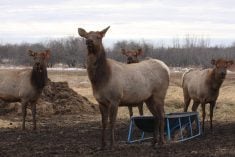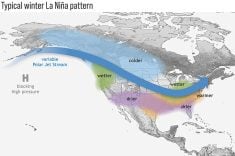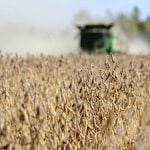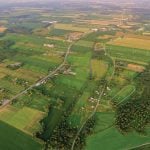When environmental engineering companies are hired to clean up abandoned oil and gas well sites, they may find old car parts, rubber boots and other garbage buried along with hydrocarbons and salt residues.
“There is a lot of stuff buried from the past,” said Perry Gerwing, president of Earthmaster Environmental Strategies in Calgary, which takes on reclamation jobs in Alberta and Saskatchewan.
The idea, said Gordon Dinwoodie of Alberta Environment, is to restore the site to be suitable for similar uses that occurred there before the disturbance.
Read Also

Canadian Food Inspection Agency extends chronic wasting disease control program consultation deadline
Date extended for consultation period of changes to CWD program
The Energy Resources Conservation Board makes sure the well stem is cut off, the well bore is plugged correctly and surface facilities are removed.
Once that is done, the energy company works with environmental engineers to start the reclamation process.
Reclamation time depends on how much work is required. A simple site might be a shallow gas well in southern Alberta where undisturbed drilling took place. This could take a few months.
On the other end of the spectrum is an abandoned oil well site with added facilities like storage batteries from the 1950s where there is potential contamination from spills or leaks. It could take years to fix these because waste management and drilling practices were different 50 or more years ago.
“In an agricultural area, there are some sites that are extremely difficult to clean up. We are grappling with how you deal with those without leaving the landowner with an issue,” Dinwoodie said.
After reclamation, sites receive an administrative review to make sure paperwork is in order and each year the government audits about 15 percent of sites to check plant growth and collect soil samples.
“If the laws weren’t there, we would be back to where we were 30 or 40 years ago, so yes, the government plays a huge role in making strides in environmental protection,” said Gerwing.
A typical lease is two acres plus land for an access road and pipelines. The site is reclaimed, assessed and remediated in two phases.
Phase one takes about 20 hours for an environmental assessment. This covers a history of the area and interviews with landowners about past activities on the site. Corporate files and databases are checked to see what drilling, surface land, production and environmental work was done as well as an examination of regulatory databases to identify reported spills.
Aerial photographs from the government help to assess what the land looked like before and after the development.
The phase two stage is more intrusive and includes soil sampling and contamination assessments on the site.
“Phase two is where we get our hands dirty,” Gerwing said.
The site visit looks for slumped areas from past excavations or disturbance, vegetation stress that could be related to contamination and visual evidence of obvious contamination or drilling waste. The site is photographed.
Remediation is the next step and soil samples are collected as deep as 10 to 15 metres to find potential plumes of chemical or salt contamination. The cores are about 15 centimetres in diameter.
“When we take samples at phase two, we are trying to find the worst potential contamination so when we are taking a bore hole sample, we take the worst one and send it to the lab,” he said.
Accredited third party commercial laboratories scan the samples for hydrocarbons, salinity and trace metals.
If there is potential for ground water contamination, ground water wells are installed and samples taken. Similar work is done on nearby surface water.
The environmental company examines the lab report for contamination levels and compares it to government guidelines. Cleanup is required if the levels exceeds provincial guidelines.
When a well is drilled, oil, natural gas and water may be found. At one time natural gas was flared off but now it is tied into the system and sold. The water often contains sodium chloride and it is re-injected back into the reservoir.
“If we have a high chloride level, and I’m saying over 400 parts per million, it is probably a salt spill related to oil and gas,” Gerwing said.
Step three is remediation. The site may be excavated and the soil disposed of at a class two landfill, a secure site that can accept non hazardous industrial waste.
Another alternative is on-site biological treatment. This is for organic contaminants like petroleum hydrocarbons that can be biodegraded on site. Soil is tilled and fertilizer and other amendments are added to assist in biodegradation.
Phytoremediation developed by Bruce Greenberg of the University of Waterloo is a new method using bacteria to biodegrade hydrocarbons and salts.
Earthmaster is involved in Greenberg’s research and development of this technology where several different kinds of naturally occurring soil rhizobacteria are extracted and turned into a seed treatment.
The bacteria cultures along the roots and removes any stress effect to the plant from salt or hydrocarbons.
“We can degrade stuff that other people haven’t been able to degrade before,” Gerwing said.
Perennial rye grass, perennial wheat grass and oats are commonly used. Densely rooted plants seeded at a high rate are preferred, to pull the salts out. Then the plants are harvested and removed.
“It is more of a passive treatment for salts for a five to 10 year period,” Gerwing said.
It takes two to three years to remove hydrocarbons with this technique. The bonus is they do not have to haul the soil away and replace it.
Once the contaminants are gone and the soil is back to normal, the final step is reclamation to make the site as close to pre-disturbance conditions as possible.
Topsoil and subsoil are recontoured to match surrounding and previously undisturbed areas before receiving a reclamation certificate from Alberta Environment.
In Saskatchewan, a certificate is not required but this company does submit an acknowledgement of reclamation form to the government.















